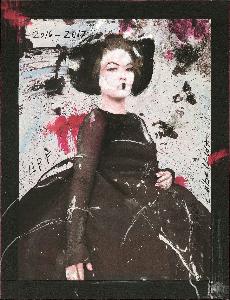Lita Cabellut
Lita Cabellut
Place: Sariñena
Born: 1961
Biography:
Early Life and Education
Lita Cabellut was born in 1961 in Sariñena, a village in Aragon, Spain. She moved to Barcelona as a child, where her mother ran a brothel. She was left under the care of her grandmother but spent most of her days on the streets selling "imaginary stars". When her grandmother died, Lita Cabellut went to live in an orphanage. At the age of twelve she was adopted by a Catalan family. During this new period she discovered the Prado Museum and became inspired by the paintings of Goya, Velázquez, Ribera and Rembrandt. Lita Cabellut moved to the Netherlands at the age of 19 to pursue her studies at the Gerrit Rietveld Academy in Amsterdam, where she studied between 1982 and 1984. During these years her work would be influenced by the Dutch masters, and she developed some of the artist techniques that have become her distinguishing mark. Art Techniques
Working on large-scale canvases, Lita Cabellut has developed a contemporary variation of the classic fresco technique and a recognizable personal palette style that comes from her obsession to provide her characters with a skin. However, beyond her most recognized works and techniques Lita Cabellut is a multi-disciplinary artist whose works also include: drawings on paper, sculptures, photography, scenography, installations, poetry, visual poems and videos. Collections
Lita Cabellut's work is grouped conceptually in collections or series of paintings. The collection Frida, The Black Pearl (2010) pays tribute to Mexican artist Frida Kahlo, in which Lita Cabellut depicts Kahlo's life while including many of her own experiences. This series inspired Lita Cabellut to create “Coco, The Testimony of Black and White” (2011), a collection that portrays this fashion icon through 35 large-scale portraits. “A Portrait of Human knowledge” (2012) continues Lita Cabellut's previous work with portraits of some of the most influential icons of knowledge from the past 150 years, including Stravinsky, Nureyev, Marie Curie, Billie Holiday, Federico Garcia Lorca, Rudolf Steiner and Sigmund Freud. With The Trilogy of the Doubt, a collection composed by socially inspired triptych paintings about power, injustice and ignorance, Lita Cabellut received attention both in her native Spain in The Netherlands. The portrait collection “Dried Tear” (2013) expresses Lita Cabellut's fascination and admiration for Asian culture. Lita Cabellut's series about the Dutch Golden Age entitled “The Black Tulip” (2014) was inspired by one of the most famous national symbols of the Netherlands. For her collection Blind Mirror (2015), Lita Cabellut explored culture and religion, focusing on some of the most influential religions that have been known to humanity. Awards and Recognition
Important to note that Lita Cabellut's work can be found in various museums and collections around the world, including the Mauritshuis, Rijksmuseum, and Gemeente Musea. Her work has also been exhibited at numerous galleries and museums, such as the Opera Gallery and Cau Ferrat Museum. https://Wikioo.org/@/Lita-Cabellut https://en.wikipedia.org/wiki/Lita_Cabellut https://Wikioo.org/Art.nsf/O/A@D3B6SX

